In this Part 4 of Ultimate Guide to Amazon Buy Box Series, I will discuss the Amazon Buy Box Algorithm and how it works. As explained in the previous articles, there are a lot of factors that affect the Buy Box Eligibility and ultimately winning the Buy Box. However, there is no set rule or a checklist that you can follow to guarantee that you will win Amazon Buy Box every time.
Previous Articles in the series:
- Amazon Buy Box – The Ultimate Guide (Part 1)
- What Is Buy Box Eligible and How to Check Buy Box Eligibility Status
- How to Win Buy Box on Amazon
Table of Contents
The complexity of Buy Box Formula
Buy Box formula takes in various different factors to determine who should get the buy box and this makes the algorithm very complex. To add to it, it is not something that will stay the same across the different categories. And even the performance metrics as well as how Amazon perceives them can change over time.
The only one factor that remains constant in determining who wins the buy box is – what are the chances that a buyer will purchase an item if a listing/offer from a particular seller is shown to the buyer?
Purpose of Amazon Buy Box Formula
Purpose of Amazon Buy Box Formula is purely to ensure that sellers strive to align with the Amazon’s goal of providing the best possible shopping experience to their customer.
Ultimately, Amazon wants people to purchase from its portal/website. It understands the offering the best possible shopping experience combined with the best value for money is the key to expand and retain its customer base.
However, with the ever-growing number of sellers on Amazon, there has to be a way to ensure that kind of quality service. Amazon Buy Box Formula does this. It helps Amazon determine which seller is providing the best value for money to its customers by evaluating which seller or offering has the right combination of pricing, best shipping standards and options, less returns coupled with high seller performance.
The right combination or the balance of these and more parameters cannot be exactly the same for all categories or kinds of products. Just having the lowest price or exceptional seller rating cannot be used to decide who will get the buy box.
So, exactly what is Buy Box Algorithm?
Understanding How Buy Box Algorithm works is not that difficult. There are no set rules. Seller offering the best shopping experience to buyers wins the Buy Box.
As an Amazon Seller, you are already aware of the various Seller Performance Metrics that Amazon uses to keep track of sellers’ performance. Those are the basis of Buy Box Algorithm (or Buy Box Formula).
When a user searches for a product, Amazon evaluates the performance metrics of eligible sellers to determine which seller is providing most value to its customer. For this,
- Amazon will break down the Eligible Sellers’ performance into various factors.
- The sellers will then be compared based on these factors.
Every factor has its own share of importance.
Some may be crucial while others may not be too important. This can be defined by associating appropriate weights with each factor.
To simplify it, let us assume there are 5 factors with following weights:
Factor 1: value = v1, weight = 0.5
Factor 2: value = v2, weight = 0.3
Factor 3: value = v3, weight = 0.1
Factor 4: value = v4, weight = 0.06
Factor 5: value = v5, weight = 0.04
So the overall performance would then be calculated as
Overall Seller Performance = v1*0.5 + v2*0.3 + v3*0.1 + v4*0.06 +v5*0.04
Going by this, clearly, a high value for Factor 5 (v5) may not matter as much as a decently high value for Factor 1 (v1) since the weight assigned to Factor 1 is much higher. So, a seller with exceptionally high value for Factor 5 but low value for Factor 1 may still lose to a seller with decent values for Factor 1 and average value for Factor 5.
We only considered 5 factors. Now imagine, Amazon tracks a lot more parameters or factors and all of them have their own weights or importance so it is difficult to predict who will win the buy box.
Importance of Buy Box Winning Factors Can Vary
As bizarre as it may sound, it is a reality. There is no fixed weight. Weights assigned to different factors used in the evaluation of performance can vary based on the product or category. For some product, Factor 1 may have high weightage while for another product or category, highest weight may be associated with Factor 5 making that more important.
This means, despite the values of all factors or performance metrics remaining the same, a seller winning Buy Box for one product may lose Buy Box for another product while competing with the same seller.
This adds to the complexity of the Amazon Buy Box Algorithm.
This can be better explained with the help of examples.
5 Examples That Highlight How Amazon Buy Box Algorithm Works?
Below I will take 5 hypothetical scenarios as examples to give you an idea of how Amazon Buy Box Algorithm works.
Example 1 – Seller Performance matters:
Let say a seller A has an established performance (selling around 100 items a month with 5-star rating).
Now Seller B joins Amazon and becomes Buy Box Eligible. It has lower prices than seller A but is not at par with A in other parameters. It has a 4-star rating, shipping around 50 items a month, and has much fewer reviews than seller A.
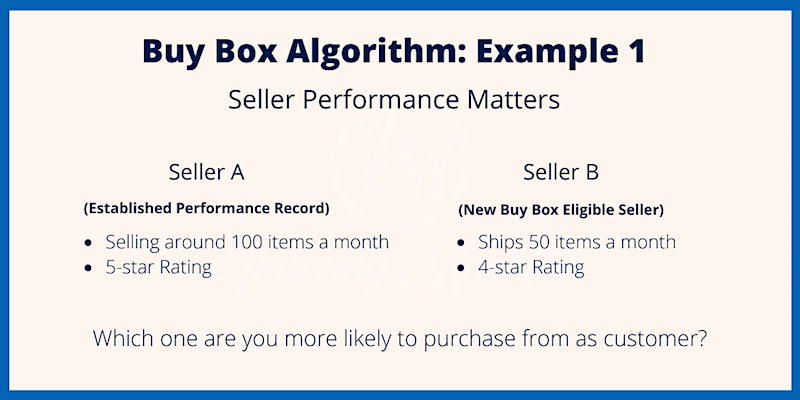
Which one would you trust more if you were Amazon? Which one are you more likely to purchase from as customer?
In my opinion, a buyer is more likely to purchase from a 5-star rating seller, especially if the price difference is not too large. It further depends on the kind of item.
What is your opinion? A or B?
Example 2 – Fulfilment Speed:
It is a festive season. Seller A and Seller B, both are Buy Box Eligible and are selling gift items.
Both A and B have 5-star ratings but A offers multiple delivery options including 1-day delivery while B offers only standard 3-4 day delivery option.
Moreover, Seller A has a slightly better track record of correct and speedy fulfilment.
Which has higher chances of a sale? Seller A or Seller B?
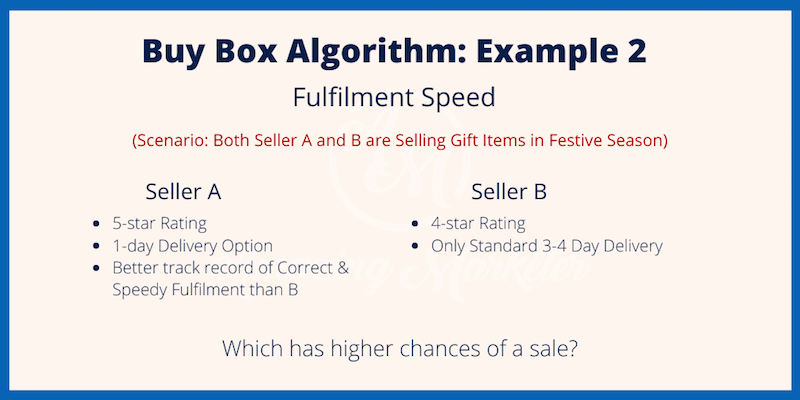
I would opt for Seller A, as getting the item well in time is more important if it’s a gift. I would not want to take any chances of missing the occasion. In such a case, wouldn’t it be to Amazon’s advantage to give the Buy Box to Seller A?
Example 3 – Price vs Seller Rating:
Seller A and B, both Buy Box Eligible, are selling an item that is fragile, let say glassware.
A prices its items lower than B and there is a good enough difference between the prices. But B has a 5-star rating and many positive reviews. Seller A, on the other hand, has a 4-star rating and a few negative reviews.
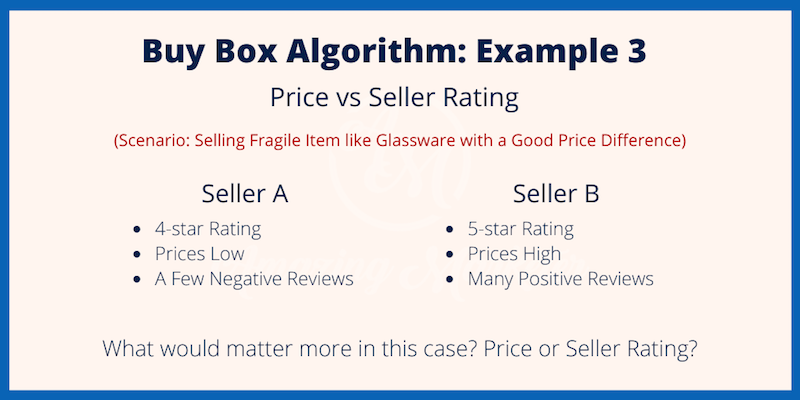
What would matter more in this case? Price or Seller Rating?
I think a buyer would rather go with Seller B as it feels as though Seller A is lowering its price to get orders but is not reliable. There would be a very small percentage of buyers who would want to take chances.
Keeping this in mind, it seems more likely that Amazon will prefer Seller B for such products.
Example 4 – When Price matters:
Let say Seller A (4.5-star rating) and Seller B (5-star rating), with overall comparable performance, are selling products with a huge price difference. A has much lower prices.
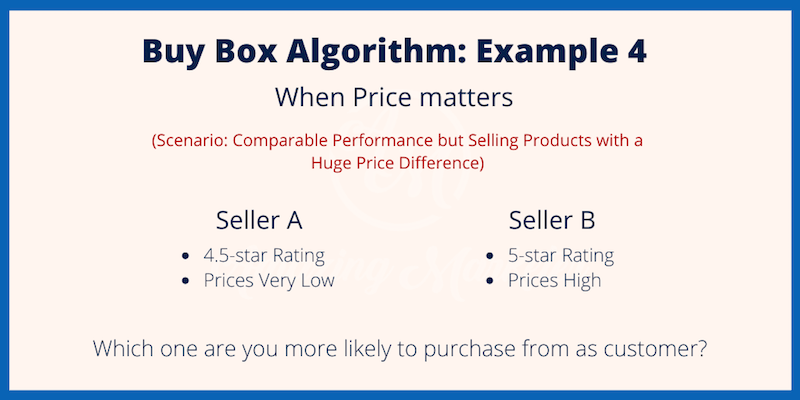
In this case, chances are higher that you would go with the one which has a lower price because the performance is comparable. Here performance may not matter as much as the price for Amazon.
Example 5 – Selling with FBA:
Seller A uses FBA and so, gets a ‘fulfilled by Amazon’ tag on its offering while Seller B ships its products itself. Both have comparable ratings and positive reviews but Seller A has priced its items slightly higher. Which one are you more likely to purchase from and why?

Seller A or Seller B? Why?
A person is more likely to trust its own service than someone else’s and the same is with Amazon. If the order is fulfilled by Amazon, the process is in its own hands and perceived as being more reliable. That is why Sellers opting for FBA have a higher chance of winning the Buy Box.
Refer these videos 👇 to learn about FBA, how it works, its merits and demerits etc.
- How Fulfilment by Amazon Works (Amazon FBA – Step-by-Step for Beginners: Part 1)
- Merits and Demerits of FBA (Amazon FBA – Step-by-Step for Beginners: Part 2)
Note: What I shared above are just simple examples and exact results may vary as there are lots of factors that Amazon considers.
Conclusion
Buy Box Algorithm considers many many factors to decide who will win the Buy Box. There is no single defining parameter that works across all situations or products.
For one product, Buy Box Formula may give importance to shipping speed while for another product it may be price. For some other product, the decision may be based on some other parameter or it could be a combination of certain parameters.
There is no sure shot way to know the exact Buy Box Algorithm or the Buy Box Formula for anyone except probably the Amazon developers working on it.
So, as I said in the beginning, the only one factor that remains constant is how likely is it that a buyer will purchase an item if a listing/offer from a particular seller is shown to the buyer!
What Next?
Buy Box is allotted on a percentage basis throughout the day. The above scenarios may hold true majority of the times but it will still not guarantee that one seller gets the Buy Box 100% of the time.
Amazon uses a process called Buy Box Rotation to ensure all eligible sellers get a chance to win the Buy Box. Likelihood of winning the Buy Box can be estimated using the Buy Box Percentage that Amazon shares with all Buy Box eligible sellers.
I will discuss this in the next article in this series – Buy Box Rotation and Buy Box Percentage on Amazon.
Stay Updated!
Make sure to subscribe to this blog, to get notified, when the next article is published.
You can also join me on your favourite social media platforms to receive real-time notification and updates related to Amazon and Digital Marketing: Facebook, Youtube, Instagram, Twitter, or Telegram
Sharing is Caring! Do not forget to share this with your friends 👇


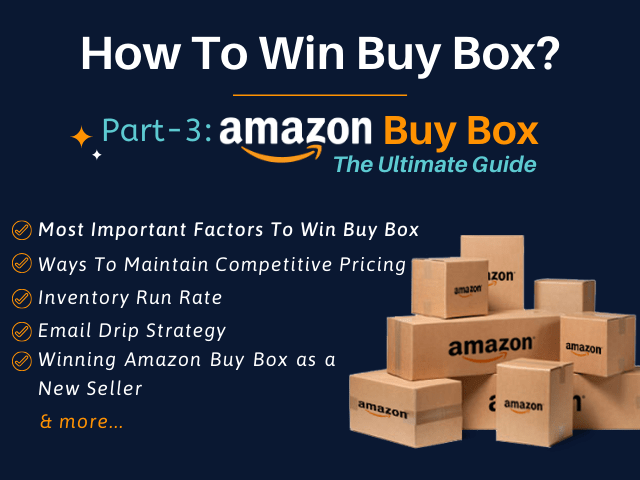







Hello, I learned very valuable information from you, but I suspended the intellectual property in my Amazon Canada store, I couldn’t open it anyway. Can you help me?
Hi Samet,
Apologies for the delayed response as your query was missed out. Really hope you have already found the solution.
If not, kindly forward the suspension mail received from Amazon at amazingmarketer24@gmail.com along with the POAs submitted so far and I will try to suggest a solution based on that.
Thanks,